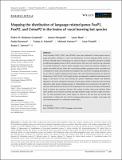Files in this item
Mapping the distribution of language related genes FoxP1, FoxP2, and CntnaP2 in the brains of vocal learning bat species
Item metadata
| dc.contributor.author | Rodenas-Cuadrado, Pedro M | |
| dc.contributor.author | Mengede, Janine | |
| dc.contributor.author | Baas, Laura | |
| dc.contributor.author | Devanna, Paolo | |
| dc.contributor.author | Schmid, Tobias A | |
| dc.contributor.author | Yartsev, Michael | |
| dc.contributor.author | Firzlaff, Uwe | |
| dc.contributor.author | Vernes, Sonja C | |
| dc.date.accessioned | 2021-03-23T16:30:08Z | |
| dc.date.available | 2021-03-23T16:30:08Z | |
| dc.date.issued | 2018-06-01 | |
| dc.identifier | 272111548 | |
| dc.identifier | 050bc7c5-832d-4552-b3d0-e168be83319d | |
| dc.identifier | 29297931 | |
| dc.identifier | 85042561988 | |
| dc.identifier.citation | Rodenas-Cuadrado , P M , Mengede , J , Baas , L , Devanna , P , Schmid , T A , Yartsev , M , Firzlaff , U & Vernes , S C 2018 , ' Mapping the distribution of language related genes FoxP1, FoxP2, and CntnaP2 in the brains of vocal learning bat species ' , The Journal of Comparative Neurology , vol. 526 , no. 8 , pp. 1235-1266 . https://doi.org/10.1002/cne.24385 | en |
| dc.identifier.issn | 0021-9967 | |
| dc.identifier.other | PubMedCentral: PMC5900884 | |
| dc.identifier.other | ORCID: /0000-0003-0305-4584/work/86538515 | |
| dc.identifier.uri | https://hdl.handle.net/10023/21694 | |
| dc.description | This work was funded by a Career Integration Grant (Marie Skłodowska‐Curie Actions) (PCIG12‐GA‐2012–333978) and a Max Planck Research Group Grant (Max Planck Gesellschaft) both awarded to S.C.V., and a Human Frontier Science Program (HFSP) Research grant (RGP0058/2016) awarded to S.C.V., M.Y., U.F. M.Y. is a New York Stem Cell Foundation – Robertson Investigator and is supported by The New York Stem Cell Foundation. | en |
| dc.description.abstract | Genes including FOXP2, FOXP1, and CNTNAP2, have been implicated in human speech and language phenotypes, pointing to a role in the development of normal language-related circuitry in the brain. Although speech and language are unique to humans a comparative approach is possible by addressing language-relevant traits in animal systems. One such trait, vocal learning, represents an essential component of human spoken language, and is shared by cetaceans, pinnipeds, elephants, some birds and bats. Given their vocal learning abilities, gregarious nature, and reliance on vocalizations for social communication and navigation, bats represent an intriguing mammalian system in which to explore language-relevant genes. We used immunohistochemistry to detail the distribution of FoxP2, FoxP1, and Cntnap2 proteins, accompanied by detailed cytoarchitectural histology in the brains of two vocal learning bat species; Phyllostomus discolor and Rousettus aegyptiacus. We show widespread expression of these genes, similar to what has been previously observed in other species, including humans. A striking difference was observed in the adult P. discolor bat, which showed low levels of FoxP2 expression in the cortex that contrasted with patterns found in rodents and nonhuman primates. We created an online, open-access database within which all data can be browsed, searched, and high resolution images viewed to single cell resolution. The data presented herein reveal regions of interest in the bat brain and provide new opportunities to address the role of these language-related genes in complex vocal-motor and vocal learning behaviors in a mammalian model system. | |
| dc.format.extent | 32 | |
| dc.format.extent | 6288670 | |
| dc.language.iso | eng | |
| dc.relation.ispartof | The Journal of Comparative Neurology | en |
| dc.subject | Animals | en |
| dc.subject | Brain/anatomy & histology | en |
| dc.subject | Brain mapping | en |
| dc.subject | Chiroptera | en |
| dc.subject | Forkhead transcription factors/metabolism | en |
| dc.subject | Learning/physiology | en |
| dc.subject | Membrane proteins/metabolism | en |
| dc.subject | Nerve tissue proteins/metabolism | en |
| dc.subject | Species specificity | en |
| dc.subject | Vocalization, animal/physiology | en |
| dc.subject | NDAS | en |
| dc.title | Mapping the distribution of language related genes FoxP1, FoxP2, and CntnaP2 in the brains of vocal learning bat species | en |
| dc.type | Journal article | en |
| dc.contributor.institution | University of St Andrews. School of Biology | en |
| dc.identifier.doi | https://doi.org/10.1002/cne.24385 | |
| dc.description.status | Peer reviewed | en |
This item appears in the following Collection(s)
Items in the St Andrews Research Repository are protected by copyright, with all rights reserved, unless otherwise indicated.

